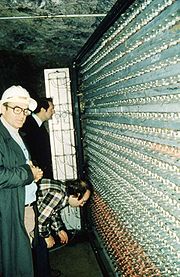
Soudan 1
Encyclopedia

Proton decay
In particle physics, proton decay is a hypothetical form of radioactive decay in which the proton decays into lighter subatomic particles, such as a neutral pion and a positron...
. It set a lower limit on the lifetime of the proton of 1.6×1030 years as well as upper limits on the density of magnetic monopoles. It also served as a prototype for the following Soudan 2 and MINOS
MINOS
MINOS is a particle physics experiment designed to study the phenomena of neutrino oscillations, first discovered by a Super-Kamiokande experiment in 1998...
experiments.
Design and operation
Soudan 1 was installed 590 meters below the surface and brought into routine operation in August 1981 by high-energy physics research groups from the University of MinnesotaUniversity of Minnesota
The University of Minnesota, Twin Cities is a public research university located in Minneapolis and St. Paul, Minnesota, United States. It is the oldest and largest part of the University of Minnesota system and has the fourth-largest main campus student body in the United States, with 52,557...
and Argonne National Laboratory
Argonne National Laboratory
Argonne National Laboratory is the first science and engineering research national laboratory in the United States, receiving this designation on July 1, 1946. It is the largest national laboratory by size and scope in the Midwest...
. The detector was a 3×3×2m3 block of taconite
Taconite
Taconite is a variety of iron formation, an iron-bearing sedimentary rock, in which the iron minerals are interlayered with quartz, chert, or carbonate...
-loaded concrete instrumented with 3456 gas proportional tubes
Proportional counter
A proportional counter is a measurement device to count particles of ionizing radiation and measure their energy.A proportional counter is a type of gaseous ionization detector. Its operation is similar to that of a Geiger-Müller counter, but uses a lower operating voltage. An inert gas is used to...
. It was surrounded on five sides by a veto shield of solid scintillator
Scintillator
A scintillator is a special material, which exhibits scintillation—the property of luminescence when excited by ionizing radiation. Luminescent materials, when struck by an incoming particle, absorb its energy and scintillate, i.e., reemit the absorbed energy in the form of light...
, which was completed in October 1981. This allowed events which might otherwise have looked like proton decay, but were actually caused by cosmic rays, to be discarded. It had a total running time of 0.97 years.

